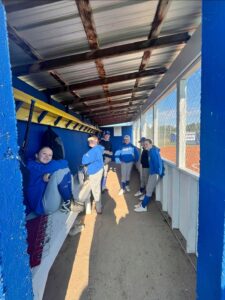
By Ashley Clementovich
The mayor and councillors of Woodlands County held an Open House last Tuesday evening. The event allowed for some two-way communication to occur between the municipal government and the public regarding the Intermunicipal Collaboration Agreements and the overall Woodlands-Whitecourt partnership which has been on the decline this past year. Councillor McQueen was regrettably absent from the panel due to health concerns.
Mayor Govenlock began the evening by giving a background philosophy of Woodlands and its residents citing the slogans such as “two communities, one future,” and “planning without borders” commonly used to describe the Whitecourt-Woodlands partnership. The mayor noted that a partnership requires trust, integration, and a need for a common purpose. “Good partnerships give more than they take,” said Mayor Govenlock.
Throughout the evening, Mayor Govenlock and council explained why they are not comfortable continuing with paying twice, through the Cost Sharing Agreement and the Linear Tax Agreement. Govenlock broke down the details of the Cost Sharing Agreement identifying cost sharing as the “expense side of equation” where numbers are allocated to provide for services and programs both mutually agreed on.
The mayor explained that the original Cost Sharing Agreement was a 10-year agreement from 2008, and was meant to expire in 2018, but automatically renewed if legal direction wasn’t provided. There was a 90-day notice window yet Woodlands only provided a 75-day notice, “even though we were dealing with serious financial shortfalls as a result of two companies in the oil and gas industry that failed to pay their taxes in the 2018 year and again have not paid in the 2019 tax year,” said Mayor Govenlock. The agreement transfers funds based on population use at 24.8 per cent of the town’s costs. In 2018, Woodlands County transferred $3,078,053 to the Town of Whitecourt.
In contrast, he explained revenue sharing as taking unallocated money out of one pot that exists in addition to services being paid for already on an agreed upon amount. “The revenue sharing says we will take some dollars and give it to you over and above, unallocated, without any strings attached in addition to paying for the services that we both agreed are beneficial to our residents.”
Mayor Govenlock further defined linear taxation as “a taxation mechanism where oil or gas pipelines that are laid throughout the municipality are subject to taxation the same as land is.” He used the word “threat” to describe the recent town council retaliation regarding the Water and Wastewater Agreement. He delved further into the details of the waterlines extended to the airport. While the Whitecourt Airport is deemed an essential service, Govenlock identified it as “a lost leader.” Currently, the mayor noted the airport is costing Woodlands an excess of $800,000 as a deficit to keep it operational when the initial number three years ago was $400,000. Whitecourt contributes $40,000 to the airport, which Govenlock pointed out does not represent five per cent.
“The facilities were built as a result of the Building Canada Grant which was matched one third by the Province of Alberta, and one third by Woodlands County. At the time, the budget, as I recall, was $8 million to extend the water line from the town’s boundaries along highway 32 to the airport and provide for the extension and the service of the Old Ferry loop. We built the line, we paid for the line, we paid for the water that runs through that line. We paid a $400,000 contribution agreement. We committed to two times the offsite levy service connection fee the town imposed on us. Then the town turns around and changes its offsite levy bylaw so the fees that we’d agreed to went from $40,000 to $120,000. That was unilaterally decided on by one partner. That adversely affected the opportunity for businesses to establish themselves in the Woodlands business park without paying that ransom fee,” said Mayor Govenlock.
The mayor then opened the floor for questions. Mike Putzke was first up to the microphone. “The success of Whitecourt and having a nice, clean, service friendly or park friendly community is a really important industry to attract people, and that’s why I think the linear is an important piece in the negotiation. Certainly, it’s a way the two groups can work together and share in building a good community. Zero isn’t the option, and 10 might not be either. Get on with the negotiating,” he said.
Brandon Anderson stepped up next to discuss the cost sharing between Whitecourt and Woodlands Fire and Rescue services, “This is a big issue. If we start not negotiating and start backing out of some of these contracts, where you are going to see individual people paying more? I would rather pay back to my county,” said Anderson.
Councillor Rennie agreed that an amount between 0 and 10 per cent is needed to be decided upon. The councillor then recalled an initial negotiating meeting between the town and county. “We sat at the table and said we needed an amount lower than 10 per cent. The town came back and asked us for 15 per cent,” he said.
Amanda St. Pierre spoke to the panel inquiring after council’s refusal to provide proof of financial hardship to the Town of Whitecourt. “If my word or the council’s word isn’t good enough for the elected representatives in the town, the trust issue has no value,” responded Mayor Govenlock.
“We should have transparency. We elected you. We should be able to see those numbers. If we’re confused with the numbers that you’ve seen posted in all these areas, and you say we’re supposed to trust you, how do we trust you if you can’t also verify what your facts are? I believe that cutting out that tax revenue is going to be detrimental to our community. Also, as a business owner, what’s the harm in showing us the facts of where this is going to affect us?” asked St. Pierre.
Mayor Govenlock assured St. Pierre that residents are free talk with the Woodlands CAO with regards to the numbers. “We do not want to destroy the partnership that has existed for years on a goodwill basis,” he said, reiterating that the goal is to keep the tax dollars generated within municipality.
County resident Charlotte Blain spoke on the wavering relationship between the town and county. “Relationships are important and they’re delicate, and they take respectful, no name calling open dialogue where people listen. And I don’t feel that’s happening. I am here in support. Personally, I want a relationship with the town. If a relationship is broken because of personality clashes, then perhaps other people should be the ones speaking at the table,” said Blain.
The town and county meet and negotiate through the Joint Liaison Committee. “If the town doesn’t want to meet, they can put different representatives in and meet with us. It isn’t strictly the obligation of Woodlands Council to change its representatives,” responded Mayor Govenlock.
Town resident Rand Richards read off a list of statistics regarding payments made between 2008 and 2018. In this time, Woodlands has given $23 million to the town while Whitecourt spent $82 million on services. Richards noted that out of Woodlands population of 4,500, 3470 are affected by the Whitecourt-Woodlands agreements. Woodlands contributes 24 per cent and Whitecourt 76 per cent. Richards asked after taking linear off the negotiations which was $6 million over past 10 years. “Is that fair for me as a Whitecourt resident to be picking up the bill for about 89 per cent of all these services that 25 per cent of the whole population in the area are paying for?”
The Mayor responded that Woodlands pays for services at 24.8 per cent, “But they also want 10.4 per cent of our taxes in addition. That’s paying twice. I don’t know what the right number is. It usually is based on the population in a geographic area that is part of that Cost Sharing Agreement,” said Mayor Govenlock. The mayor added that the $6 million is something they want to spend in Woodlands County.
Councillor Burrows added, “If you ask any of the businesses around since 2014, we’re all taking a beating and things are not what they were in 2013. In 2012, things were pretty good then. Things need to be looked at. I think everything needs to be on the table. I think people have to take personalities and they have to part them at the door, and that’s both sides.”
There were several concerns voiced around access to the Millar Centre and paying more for services within Whitecourt if the partnership was to fall through. “I completely agree that these services are essential, but we need to figure out a number on the value of them. And there’s a certain point at which it becomes unsustainable to continue to raise taxes based on those numbers. At what point do we push back and say, you know what? We’re paying enough,” said Councillor Burrows.
“I know what it means to spend my own dollars. I don’t spend frivolously your dollars either. I take it seriously and so do my colleagues. We are planning for future growth that accommodates our partners, but I don’t want to be in competition. I want to work with them, but it’s got to be fair, equitable, considerate of my capacity, my residents’ capacity, and sustainable in terms of the impact that it has on our taxpayers,” said Mayor Govenlock.
Kelly Yuhar addressed the allegations made by the town about Woodlands CAOs. Mayor Govenlock explained that Gordon Frank is currently the interim CAO. Luke Mercier was the Woodlands CAO for 15 years and handed in his resignation of October 2018 after choosing to move to another county. Woodlands hired an interim CAO until a proper fit for the position could be found. One individual was selected but turned out to be a poor fit.
The mayor also addressed Yuhar’s inquiries after the town letter from June 20 which rejected the Tax Revenue Sharing Agreement unless proof of financial hardship was provided. “We won’t be allowing the town to dictate to Woodlands County the taxes we impose on our residents, the services we provide, or any of the other ransom, ridiculous demands,” responded Mayor Govenlock.
Having attended both town and county meetings, Leo Breikreitz made his own inferences regarding the municipalities. “This situation was triggered by a revenue problem with several oil companies not paying their taxes. I think what that did, though, was to expose the real issue which is an expenditure problem.” Breikreitz predicted both town and county needed to reduce their expenditures due to of a lack of revenue.
Much weighs on the upcoming mediator meetings which will help the town and county to identify specific protocol to continue dialog. The separate meetings require notification by August 20. “We don’t want these to be public dialogues. We want these to be discussions behind closed doors, so that we can sit down and say things that are perhaps not pleasant,” said Mayor Govenlock.
“We share the linear for the entire county. I’ve got pipelines in my area that were put in the ground in the 1960s that we need to share with the Town of Whitecourt. “If we’re going to share things, let’s sit down and have the discussion, period. Not just take it off the table,” said Councillor Klein.
Councillor Burrows’ closing remark centered on increasing the level of candor regarding the dollars being exchanged between the town and county.
Mayor Govenlock and councillors thanked the public for attending the evening, for their questions, and for the Woodlands administrative team who put together the information presented to the public.







More Stories
Community spirit shines at large-scale youth baseball event
Birthday party chaos sung beautifully by Pumpjack Players’ youth in spring musical
Gearing up for another season of cars, cruising and camaraderie